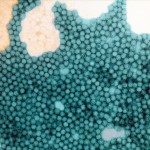Lien vers Pubmed [PMID] – 9893712
Cell. Mol. Life Sci. 1998 Dec;54(12):1385-402
As viral persistence is of major medical importance, well-characterized, simple models are needed to improve our understanding of persistent infections. We have chosen to study the molecular mechanisms of viral persistence with the poliovirus (PV), because this picornavirus is one of the best characterized animal viruses, it infects the central nervous system which is a target organ for viral persistence, and it belongs to the Picornaviridae family of viruses, which includes several naturally persisting viruses. We have developed models of PV persistence in neuronal and epidermoid cells, and the present review will focus on the latter one because both lytic and persistent PV strains can be used to study the PV-HEp-2 cell interactions. The viral determinants of persistence have been investigated with this model, and PV determinants have proven to be of crucial importance for the establishment of persistence in HEp-2 cells. Precise determinants of PV persistence have been identified for PV serotypes 1 and 3, in capsid proteins VP1 and VP2. These determinants modify the early steps of the PV cycle, and in particular, the conformational modifications of the capsid following virus adsorption onto its receptor. These results permit us to propose several hypotheses concerning PV persistence and the early steps of the PV cycle.
